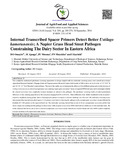| dc.contributor.author | Omayio, DO | |
| dc.contributor.author | Ajanga, SI | |
| dc.contributor.author | Muoma, JV | |
| dc.contributor.author | Muyekho, FN | |
| dc.contributor.author | Kariuki, I | |
| dc.date.accessioned | 2023-10-05T14:45:22Z | |
| dc.date.available | 2023-10-05T14:45:22Z | |
| dc.date.issued | 2014-09-30 | |
| dc.identifier.uri | http://ir-library.mmust.ac.ke:8080/jspui/bitstream/190/291/1/omayio%20JAAS%20September%202014.pdf | |
| dc.identifier.uri | http://ir-library.mmust.ac.ke:8080/xmlui/handle/123456789/2335 | |
| dc.description.abstract | Two completely randomized glasshouse screening experiments in design coupled with two molecular screening assays were carried out at Kenya
Agricultural Research Institute’s Muguga South and Trypanosomiasis Research Centres both located at 2095m above sea level at the (1o 13’ 53.0” S)
and (36o 38’ 1.1” E) of Kiambu County in Kenya. The aim of the studies was to determine the efficacy of four different primer pairs in the detection of
Ustilago kamerunensis in selected asymptomatic (non-smutting) napier grass accessions’ tissues at expected PCR band sizes and to investigate whether
the selected accessions were completely resistant (immune) or tolerant to the pathogen. The glasshouse screening results revealed predominant
differences in the smutting proportions of the accessions ranging from 0% to 90.22%. These differences were further manifested in the accession’s
respective neighbour joining groups where a heterogeneous pattern in response to disease challenge was observed. The molecular screening assays
demonstrated that internal transcribed spacer (1 / 4) primers were better in detecting the pathogen in the asymptomatic accessions’ tissues followed by
β-tubulin (F1 / R2) primers at the expected band size. The molecular screening showed that ten out of eleven asymptomatic accessions and the four
checks despite not smutting had the pathogen in their tissues with exception of accession 16806 which did not exhibit any in both molecular trials. The
results indicated that the ten out of eleven selected asymptomatic accessions to head smut disease seemed tolerant and only 16806 seemed completely
resistant (immune) to the napier head smut disease | en_US |
| dc.language.iso | en | en_US |
| dc.publisher | Journal of Agri-Food and Applied Sciences | en_US |
| dc.subject | Internal, Transcribed, Spacer, Primers, Detect, Better, Ustilago kamerunensis;, Napier Grass, Head, Smut ,Pathogen, Constraining, Dairy Sector | en_US |
| dc.title | Internal Transcribed Spacer Primers Detect Better Ustilago kamerunensis; A Napier Grass Head Smut Pathogen Constraining The Dairy Sector In Eastern Africa | en_US |
| dc.type | Article | en_US |
| dc.type | Book | en_US |

